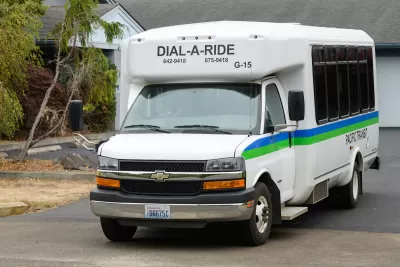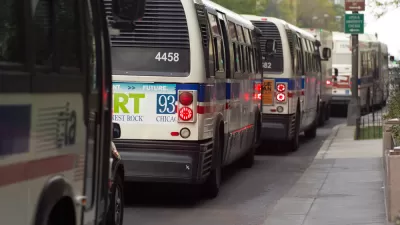On-demand services can’t scale successfully without massive government subsidies, and could obscure the impacts of car-centric sprawl.

As more cities opt for on-demand transit services, often labeled ‘microtransit,’ to supplement or even replace fixed-route transit, David Zipper highlights one major problem with relying too heavily on microtransit.
For Zipper, the surface benefits of microtransit are obvious. “The allure of cheap, responsive, door-to-door transit service is seductive, particularly for public leaders eager to ‘reimagine’ fixed-route bus service that fails to inspire.”
The hard part comes when public officials try to scale microtransit service without breaking their budget, limiting how many trips people can take, or morphing into something that looks a lot like fixed-route service.
Whereas fixed-route service offers economies of scale—“As long as empty bus seats are available, each new rider brings new revenue to the transit agency while incurring minimal added costs, thereby reducing the subsidy required for each trip”—“An increase in microtransit trips can quickly overwhelm the system’s capacity, in part because vans have only a handful of seats, but especially because passengers’ itineraries often do not overlap.”
Ultimately, the system doesn’t work as public transit without significant public subsidies. “In Los Angeles, for example, a microtransit ride costs passengers only $1, but each one receives a $42 subsidy.”
Additionally, Zipper notes, microtransit “shields people from the inefficiency of car-centric land use.” Ultimately, “For the sake of the planet, as well as efficiency, transportation should be more expensive in places that are difficult to access without a car.”
FULL STORY: On-Demand Microtransit Can’t Escape This Big Problem

Alabama: Trump Terminates Settlements for Black Communities Harmed By Raw Sewage
Trump deemed the landmark civil rights agreement “illegal DEI and environmental justice policy.”

Planetizen Federal Action Tracker
A weekly monitor of how Trump’s orders and actions are impacting planners and planning in America.

The 120 Year Old Tiny Home Villages That Sheltered San Francisco’s Earthquake Refugees
More than a century ago, San Francisco mobilized to house thousands of residents displaced by the 1906 earthquake. Could their strategy offer a model for the present?

Ken Jennings Launches Transit Web Series
The Jeopardy champ wants you to ride public transit.

BLM To Rescind Public Lands Rule
The change will downgrade conservation, once again putting federal land at risk for mining and other extractive uses.

Indy Neighborhood Group Builds Temporary Multi-Use Path
Community members, aided in part by funding from the city, repurposed a vehicle lane to create a protected bike and pedestrian path for the summer season.
Urban Design for Planners 1: Software Tools
This six-course series explores essential urban design concepts using open source software and equips planners with the tools they need to participate fully in the urban design process.
Planning for Universal Design
Learn the tools for implementing Universal Design in planning regulations.
Clanton & Associates, Inc.
Jessamine County Fiscal Court
Institute for Housing and Urban Development Studies (IHS)
City of Grandview
Harvard GSD Executive Education
Toledo-Lucas County Plan Commissions
Salt Lake City
NYU Wagner Graduate School of Public Service





























